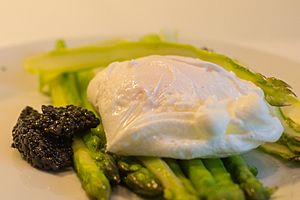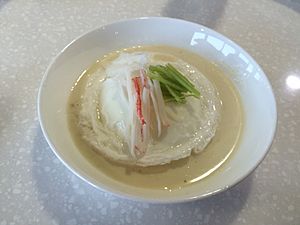Poached egg facts for kids

A poached egg served with asparagus
|
|
| Main ingredients | Eggs |
|---|---|
A poached egg is an egg cooked without its shell. It's made by gently cooking the egg in hot water, but not boiling water. This way of cooking makes the egg very soft and delicate, much softer than if you boiled it.
Contents
How to Make a Poached Egg
To make a poached egg, you first crack an egg into a small cup or bowl. Then, you carefully slide the egg into a pan of water that is warm, but not boiling. The water should be about 75° C (167 °F).
The egg cooks until the egg white becomes firm, but the yolk stays soft and runny. A perfect poached egg has a runny yolk, a firm white on the outside, and no uncooked white left. In places where chickens are vaccinated against salmonella, it's usually safe to eat eggs with a runny yolk.
When an egg is put into water at the right temperature, the white wraps around the yolk. This helps the egg cook nicely, with the white firm and the yolk soft.
Sometimes, parts of the egg white can spread out in the water and create a foam. To stop this, you can strain the egg first to remove the thinner part of the white. Adding a little bit of vinegar to the water can also help. Vinegar is acidic, and it makes the egg white cook faster. Stirring the water to create a vortex (a swirling motion) can also help keep the egg white together.
How fresh the egg is also matters. Very fresh eggs are less likely to spread out in the water. If eggs are not as fresh, their whites might spread more. In this case, adding vinegar to the water is very helpful.
Steamed Eggs: A Similar Method
Sometimes, people use the word "poaching" for a method that is actually closer to "coddling" or steaming. This method uses a special pan called an "egg-poacher."
An egg-poacher is usually a wide pan with an inner lid. This lid has holes that hold several small, round cups, each for one egg. Another lid goes over the top. To cook the eggs, you fill the pan with water and bring it to a gentle simmer or boil. The top lid traps the steam, which cooks the eggs all around. The cups are often buttered so the cooked eggs can be easily removed.
Eggs cooked this way are similar to coddled eggs. However, steamed eggs are often cooked longer, so they tend to be firmer. These eggs are often served on buttered toast.
Steamed eggs are popular for home cooking because they are easier to make consistently. But in professional kitchens, poached eggs are often preferred. This is because it's easier to cook many poached eggs at once without needing special equipment.
Dishes with Poached Eggs Around the World
Poached eggs are a key part of many tasty dishes:
- Eggs Benedict: This is a classic American breakfast dish. It features poached eggs, often served with ham or bacon, on an English muffin, topped with a creamy hollandaise sauce. Other similar dishes include Eggs Florentine and Eggs Mornay.
- Louisiana Creole Dishes: In Louisiana Creole cuisine, poached eggs are used in many brunch dishes. Examples include Eggs Sardou, Eggs Portuguese, Eggs Hussarde, and Eggs St. Charles.
- Eggs in Soup or Broth: In some cultures, poached eggs are served right in a soup or broth.
- In central Colombia, a popular breakfast is changua, which is eggs poached in a broth made with scallions, coriander, and milk.
- The North African dish shakshouka has eggs poached in a spicy tomato sauce.
- Italian Style: In Italy, poached eggs are often seasoned with grated Parmigiano Reggiano cheese and butter or olive oil.
- Portuguese Style: In Portugal, poached eggs are called ovos escalfados. They are usually served with boiled peas and chouriço sausage.
- Korean Suran: In Korean cuisine, poached eggs are known as suran (수란). They are topped with different garnishes like chili threads, rock tripe threads, and scallion threads.
- Turkish Çılbır: The Turkish dish çılbır includes poached eggs, a yogurt sauce with garlic, and butter with red peppers.
- Bulgarian Style: In Bulgaria, poached eggs are served on yogurt, often with sirene cheese. They are topped with butter and paprika. This dish is called Panagyurishte-style eggs.

Images for kids
See also
 In Spanish: Huevo escalfado para niños
In Spanish: Huevo escalfado para niños





